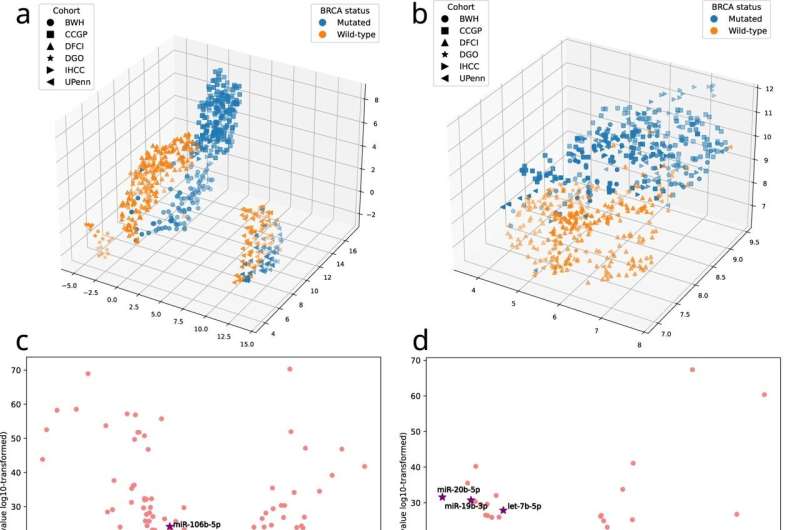This article has been reviewed according to Science X's editorial process and policies. Editors have highlighted the following attributes while ensuring the content's credibility:
fact-checked
peer-reviewed publication
trusted source
proofread
New study suggests simple test could detect breast and ovarian cancer risk without genetic sequencing

Researchers from Dana-Farber Cancer Institute, Brigham and Women's Hospital, and Medical University of Lodz have found a way to detect increased cancer risk associated with BRCA1 and BRCA2 mutations without genetic sequencing, according to a new study in Nature Communications.
The assessment isn't based on the presence of BRCA1/2 gene mutations. Rather, it's based on functional changes that occur when the pathway those and other genes regulate is not working properly. "For the first time, we have found a signal in the blood to detect pathology associated with increased cancer risk," says senior author and Dana-Farber researcher Dipanjan Chowdhury, Ph.D.
This new way of detecting risk could become the basis for a more accessible, affordable, and potentially more comprehensive way to detect an inherited risk of breast or ovarian cancer.
The BRCA1 and BRCA2 genes are part of a broader pathway that regulates DNA repair. Certain mutations in these genes make the repair pathway less robust and increase the risk of breast, ovarian, pancreatic, or prostate cancer. In the US, genetic testing for mutations in these genes might be recommended for people with a family history of these cancers. People who test positive have the option to pursue additional screening or surgery to reduce or eliminate their risk of developing cancer.
However, of the estimated 1 million suspected BRCA1/2 mutation carriers in the US, only 10% know they are carriers. In India, testing for BRCA mutations is not even available. A more accessible means of detection could make it possible for many more people to learn of an inherited elevated cancer risk.
"What if we had an accessible and affordable test for inherited cancer risk that you can get done as an annual physical, the same way we test for diabetes or heart disease risk?" says Chowdhury. "These study results suggest that such a test is in the realm of possibility."
The signal of increased risk Chowdhury found in the blood is the presence of a specific constellation of microRNAs. MicroRNAs are short, non-coding, hairpin-shaped RNA molecules that circulate in our blood. They are increasingly being used as disease biomarkers.
The presence of one specific constellation of microRNAs is a sign of the active breakdown of that DNA repair process—a bit like the distinct knocking a car engine might make when one of its components starts to fail. The absence of that constellation is a sign of a working DNA repair process—quiet like an engine that purrs.
In the proof-of-concept study, the team analyzed blood samples from 653 people from six biorepositories, four in the US, one in Poland, and one in India. About half of the samples were confirmed to have BRCA mutations and half not.
The team used next generation sequencing to identify the microRNAs in each sample and created a data set containing the microRNAs and BRCA mutation status for each sample. Chowdhury's collaborators at the Medical University of Lodz used machine learning to identify a signature—that unique constellation of microRNAs—seen only in those samples positive for BRCA mutations.
The model they created was correctly identified the presence of BRCA mutations in 94% of cases, providing strong validation that the signal is a new way to identify an elevated risk of cancer.
This proof-of-concept study rigorously evaluates the validity of the signal and does not form the basis for a clinical test that could be used in an annual exam. However, an affordable clinical test is feasible.
PCR tests—the same technology used to detect COVID-19 infections—can be used in place of next generation sequencing to detect the microRNA signature, making it affordable and accessible. In addition, says Chowdhury, the accuracy of the model used to detect the microRNA constellation will improve as it is trained using larger and larger datasets.
Chowdhury hypothesizes that the test could also be a more comprehensive indication of elevated risk compared to genetic sequencing of the BRCA1 and BRCA2 genes because the test captures signs of pathology in action—no matter which gene mutations cause it. Currently, genetic testing captures only known flaws in a few known genes in the genome that could interrupt the DNA repair process.
"We are constantly discovering new genes and mutations that could impact this pathway, so it is hard for genetic testing to keep up," says Chowdhury. "A test that is independent of that, that shows you have a problem in the pathway, could more broadly identify people at risk."
Building on this work, Chowdhury has a clinical study underway now to investigate the possibility that a similar test could be used to screen for early-stage ovarian cancer. The investigation is inspired by a previous retrospective study suggesting that a distinct constellation of microRNA appears when cancer begins.
More information: Kevin Elias et al, Identification of BRCA1/2 mutation female carriers using circulating microRNA profiles, Nature Communications (2023). DOI: 10.1038/s41467-023-38925-4


















